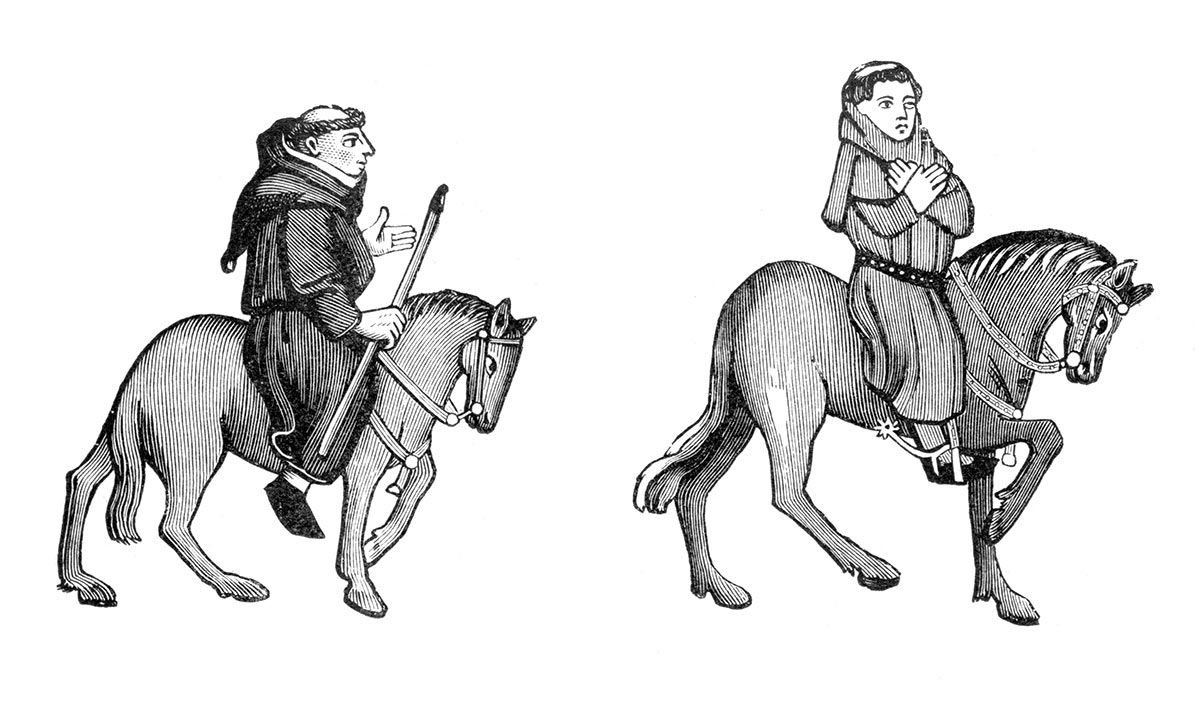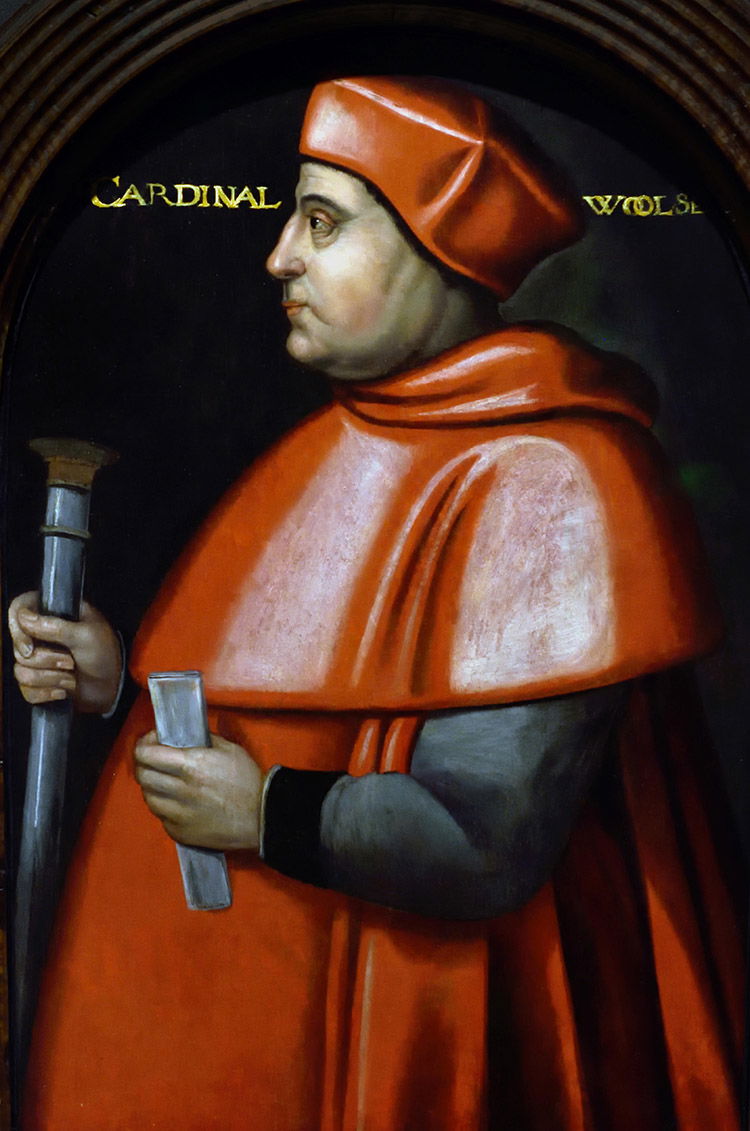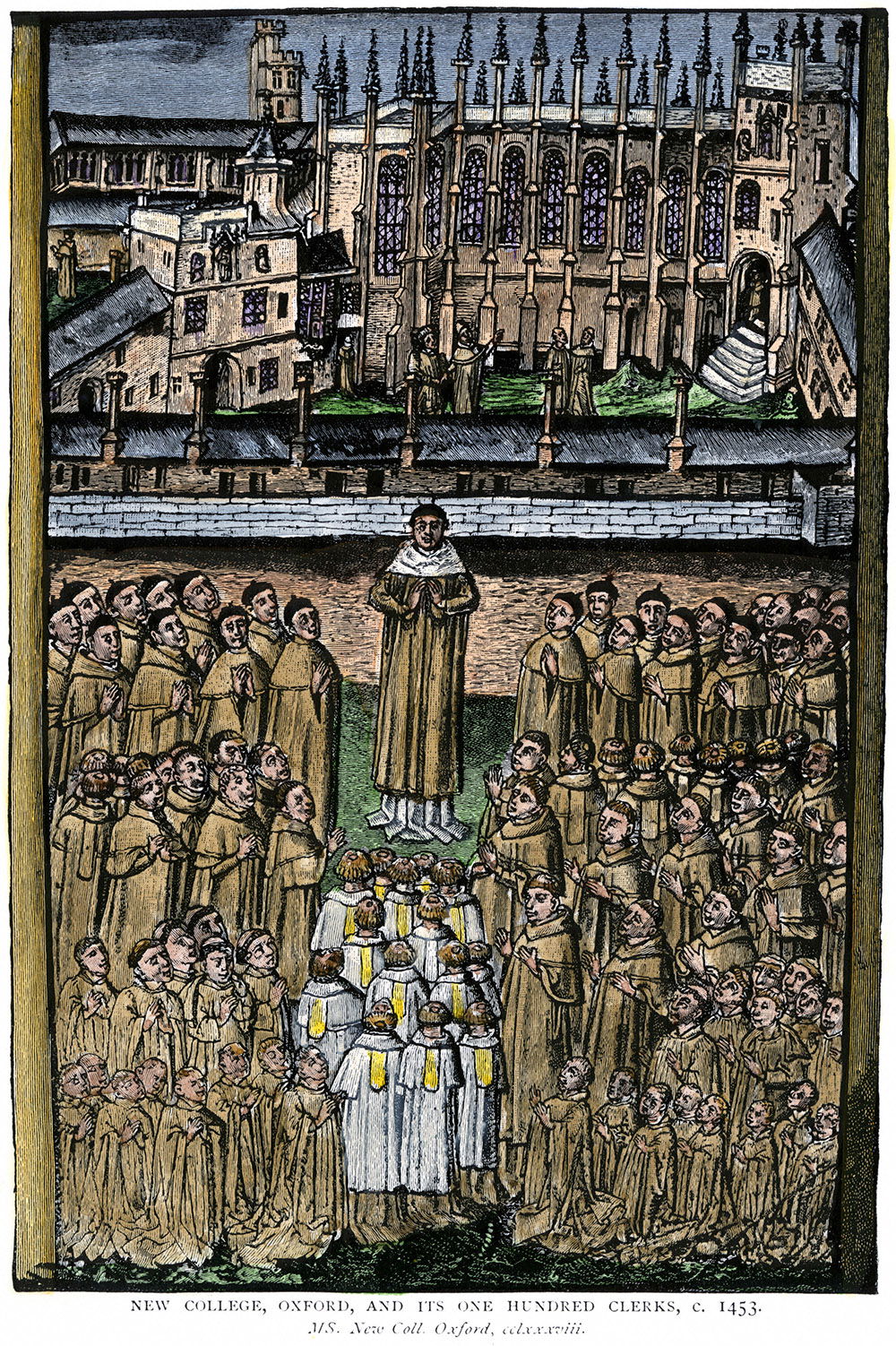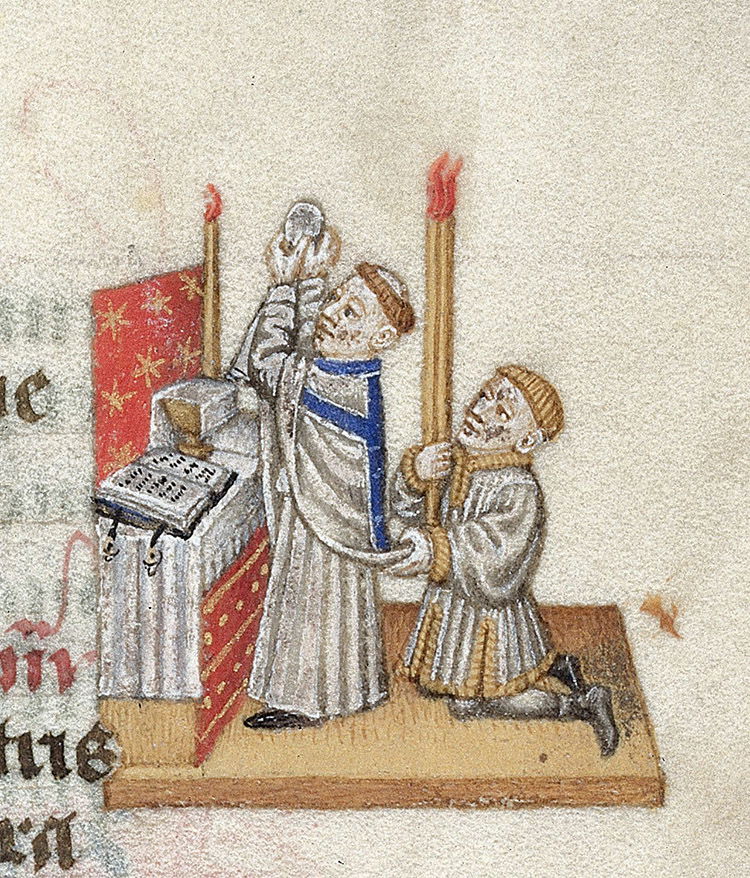The Medieval Gig Economy
While the great and good of the medieval Church secured lucrative and influential posts, the average parish priest was often forced to juggle a variety of casual jobs to make ends meet. The ‘gig economy’ – of which we hear so much today – was part of everyday life in medieval England.

The Friar and Parson, from the Ellesmere Manuscript of the Canterbury Tales
For a young man on the make in late medieval England, there were numerous career options. Professions such as the law were emerging, with the Inns of Court providing tuition in Common Law and jurisprudence. At an average cost of £13 per year for board and tuition, however, this was prohibitively expensive to all but the sons of landowners, wealthy craftsmen and merchants. Those less well-off might consider a career in the military. Fighting France could earn wealth and fame through plunder, while the ransom of a man-at-arms or even a nobleman could produce a fortune, providing the astute young soldier with enough money to settle down to a comfortable life as a landowner. There was no greater or more prestigious career, however, than the Church.
During and after the break with Rome in the early 1530s, Protestant propaganda portrayed the late-Medieval Catholic Church in an unflattering light. Horror stories of clerical abuse and tales of drunken, lecherous priests and fornicating monks made sensational propaganda for Thomas Cromwell’s commissioners in the face of popular opposition to the Reformation. One of the reasons for the Dissolution of the Monasteries was the lacklustre purity of monks and the poor quality of education they gave their novices. Much criticism was levelled as the quality of the clergy, their supposed neglect of pastoral care and their personal immorality. The legacy of protestant criticism influences English perceptions of the Catholic Church to this day. Yet a closer look at the late medieval Catholic Church shows that, like any profession, it had its own peculiar pressures, critics and supporters.
Rot at the top
At its highest echelons, the Catholic Church was worldly and inextricably linked to secular politics. The most prominent churchman of the day, Cardinal Thomas Wolsey, certainly exploited his office to enrich himself and assert his status, but he was also a diligent church overseer. In the 1520s, when he served as Archbishop of York and Papal Legate to England, two offices that gave him extraordinary power over the Church, discipline improved. He oversaw enquiries into the conduct of the clergy, such as reforming the Benefit of the Clergy in 1528, which made monks and priests accountable for crimes in the Royal Courts. Though Wolsey was criticised for his seizure of monastic lands to endow his new Oxford College, Christ Church, those houses which he did dissolve were generally small, unsustainable and already failing. If we compare him to his fellow English cardinals – Cardinal Henry Beaufort (uncle to Henry V) and John Morton (Lord Chancellor to Henry VII) – we find that all three were assertive, worldly figures who were nevertheless much given to the cause of the Church. Morton stamped his coat of arms on the renovated spire of Canterbury Cathedral, which he had funded. Beaufort’s enormous wealth was loaned to his nephew Henry VI to pursue war in France, but he was also instrumental in organising the Europe-wide Catholic battle against Hussite heretics in Bohemia, marshalling Crusader forces in the 1420s to crush the supposed enemies of the Church and was a leading figure in the Council of Constance which, between 1414 and 1418, ended the schism within the Western Church.

The link between the Church and the secular world is visible in acts such as Archbishop Arundel’s masterminding of Henry IV’s usurpation in 1399 as well as the ubiquity of bishops on the royal councils of Yorkist and Lancastrian monarchs, of whom Wolsey was simply the most flamboyant and powerful. Yet as peers of the realm – bishops and abbots sat alongside the secular nobility in the House of Lords – they had a certain image to maintain. While often criticised from within and without the Church, they took their clerical duties seriously, if not themselves, then deputising suitable men to run their dioceses while they were at court or on diplomatic missions.
The prestigious backgrounds of the men who led the English Church should surprise no one, but they were far from representative of the average parish priest. Just as a wealthy family today might expect their children to become teachers at prestigious public schools rather than in the state sector, or military officers rather than frontline infantry, so too did the rich and powerful of the late medieval period expect their sons to become Princes of the Church, rather than common priests. In comparison to their elevated superiors, the average priest was expected to be a moral, learned man who would see to the needs of his flock. As Chaucer wrote in The Clerk’s Tale he was to be:
Rich of thought and work
He was also a learned man, a clerk
That Christ’s gospel gladly he would preach
His parishioners devoutly he would teach.
Priests in the late middle ages were expected to be many things and fulfil many functions, but above all they were expected to be holy and unworldly men. They were to live what was then known as the Vita Apostolica – in the manner of the Apostles – in poverty, celibacy and given only to God and His work.
Priests on the frontline
Yet the expectations placed upon priests in late medieval England were hampered by a lack of systematic training. Cardinal Pole, Mary I’s Archbishop of Canterbury during her reign and one of the masterminds behind her attack on the English Reformation, proposed seminaries be founded in every diocese to train priests capable of reinstating and restoring Catholic moral authority. This suggestion was later taken up by the Church as a whole at the Council of Trent in 1563. Yet before the break with Rome, there was no formal means of training any cleric. The Universities of Oxford and Cambridge provided a strong theological education. The numbers of graduates holding clerical offices increased from eight per cent in the early 15th century to 42 per cent in the 1530s. Clearly, the Church agreed with Chaucer that a good education was desirable in a clerical appointee. Not all priests, however, enjoyed a university education. The wills we have of parish priests testify to their concern with learning, but not in the refined manner of the universities. As Anthony Saunders, parish priest of Winchcombe, wrote to Thomas Cromwell in 1535:
I have too little time to study and to preach and to read the lively word of God (as is my duty) as constantly as I would be glad to do.
Priests possessed books with titles like The Layfolk’s Catechism or Instructions for Parish Priests, both produced in the late 14th century to serve as primers for preachers who faced greater lay demand for a preaching, educated clergy. From these wills and testaments, we get the impression of a regular clergy who knew that the people wanted them to be better educated and qualified, but simply did not have the time or money to access the rigorous education they required. Without the resources or patronage to attend universities in England, let alone travel to the great seats of learning in Paris or Bologna, they had to make do with what they could learn themselves from the wide array of commonly printed religious texts available to the public in the late medieval period.

The difference in career paths between young graduates entering the Church from Oxford or Cambridge and those whose learning was more limited reveals a divide at the heart of the organisation. Those who held degrees, or had good connections, were likely to rise high in the Church and make their fortunes. Many lucrative benefices – a permanent appointment providing property and income – were held by such individuals. A relatively small elite of educated, connected priests existed, but they were by and large occupied with administrative roles rather than pastoral ones. Just as in a modern day company, where talent is rewarded with pay rises and greater managerial responsibility, talented clerics were taken away from the ‘front line’ in order to better manage the church and its enormous revenues, and to probe the major theological issues that threatened the church’s moral fabric.
Before the English Reformation, the Catholic Church had undergone a century of dramatic change. Chantries were established as a form of trust fund left by wealthy patrons for the purpose of employing a priest to sing a stipulated number of masses for them after their death. These provided livings to many priests, who did little other than celebrate Masses. Many parish churches, meanwhile, came to be controlled by corporate bodies or were ‘farmed out’ by absentee landowners. These wealthy patrons – often secular lords or distant landowners – rarely had much of an incentive to look after the spiritual wellbeing of those who lived on their lands and so had every incentive to cut costs when the time came to select a new priest. As Canon Richard Watson, the clergyman and historian, observed: ‘every year down to dissolution saw further rectories reduced to vicarages’ – independent, beneficed clergy were replaced by part-time priests who filled in for them.
This part-time employment was an increasingly common way for many priests to secure a benefice to earn a living. A chantry priest might earn between four and six pounds a year, a tiny sum for what was a relatively skilled job. Archbishop Chichele of Canterbury recorded a vicar who had been given a chantry by a layman patron: ‘out of charitable intent, considering the scarcity of chaplains and the poverty of said vicarage.’ Many priests, the rank and file of the clergy, were precariously employed, often by multiple patrons. A typical member of this class may have sung masses for a wealthy patron at a chantry a few days of the week, then celebrated mass as a vicar on behalf of an absentee curate on Sundays, while later serving as a bailiff or other secular officer for another patron to make ends meet. The Vicar of Stalham, for example, served as a retainer for the Paston family in Norfolk in the mid-15th century. Although today the terms ‘ ‘Rector’ and ‘Vicar’ seem interchangeable, before the Reformation they were the difference between a secure, tenured position and a subordinate, precarious employee. Employment by the gentry led to yet greater criticism of the clergy for their complicity in evictions, tax collection and the other small injustices committed on the common folk by the landed elite.
Brain drain
Until at least the 1520s there was no crisis of recruitment within the English Church. There were always those willing to become ordained. Yet, as described, ordination did not automatically mean that one received a benefice, allowing one to settle down into the quiet life of a country parson, spend one’s time composing sermons and reading scripture. Rather, it often meant precarious piecework which depended on the demands of lay consumers of religious services. Benefices became to priests what tenured professorships are to today’s academics – dreamed of, career-defining appointments that guaranteed a livelihood, but which were becoming rarer and rarer. The historian Keith Thomas characterised this as: ‘Living from death to death, literally singing for [their] suppers as one series of post-mortem masses followed another’.

This lifestyle did not just affect the young new cleric. Many dioceses, especially Irish ones, were so poor that their bishops also served as assistants to their English peers. As the historian Hamilton Thompson wrote: ‘when assistance was wanted, there was always a bishop of Philippopolis or Sidon, Annaghdown or Colyne, ready to accept an offer of temporary work’. John Chourles, Bishop of Dromore, worked as an assistant to the Archbishop of Canterbury and the bishops of London and Rochester from 1419 to 1421, while the actual bishops were busy at Court. While working as an assistant bishop was no doubt more lucrative than being a regular vicar or chantry priest, it speaks to the inequality of opportunity and wealth within the Church.
The gig economy
The late medieval church has much to tell us about contemporary developments in society. A prestigious profession, whose ordained members were imbued with supernatural powers of transubstantiation and who were seen as men of great learning and influence on both a local and national level, became progressively hollowed out. A relatively small number of well-connected and well-educated men took over the most lucrative and prestigious offices, leaving a mass of less fortunate peers to perform the actual functions of the church. Common people were less likely to encounter a proper priest than they were a poorly paid, temporarily employed vicar, whose education largely consisted of hurriedly reading primers designed specifically to bring him up to speed on the Sacraments and functions of a cleric. This de-professionalisation of the church left it wide open to external attacks and criticism. Because of its lacklustre provision of frontline services, the entire edifice of the English Church came under assault until eventually it was revolutionised during the Protestant Reformation, which brought enormous changes to how priests were trained, recruited and employed. With the ‘gig economy’ much in the news these days, and professions such as the law, healthcare, teaching and academia becoming ever more casual and commercialised, modern Britain’s professional institutions may themselves encounter their own Reformation, as their overworked, under-supported members find themselves unequipped to handle popular dissatisfaction with the quality of their services.
David Long is a London-based writer and historian.